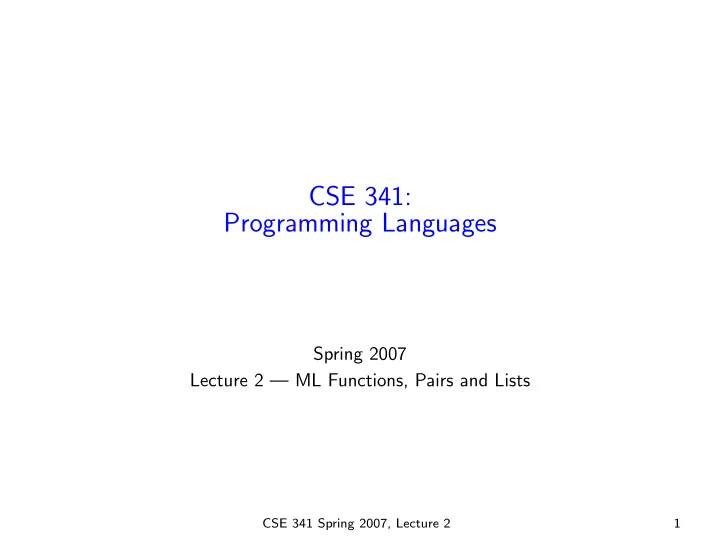

CSE 341: Programming Languages Spring 2007 Lecture 2 — ML Functions, Pairs and Lists CSE 341 Spring 2007, Lecture 2 1
Goals for today • More ML essentials • Discuss some “first-week” gotchas – We will learn more and better constructs soon Note: These slides (and most slides all quarter) will make much more sense in conjunction with the corresponding code file ( lec02.sml ). Recall a program is a sequence of bindings... CSE 341 Spring 2007, Lecture 2 2
Function Definitions ... A second kind of binding is for functions Syntax: fun x0 (x1 : t1, ..., xn : tn) = e Typing rules: 1. Context for e is (the function’s context extended with) x1:t1, ..., xn:tn and : 2. x0 : (t1 * ... * tn) -> t where : 3. e has type t in this context (This “definition” is circular because functions can call themselves and the type-checker “guessed” t .) (It turns out in ML there is always a “best guess” and the type-checker can always “make that guess”. For now, it’s magic.) Evaluation: A FUNCTION IS A VALUE. CSE 341 Spring 2007, Lecture 2 3
Function Applications (a.k.a. Calls) Syntax: e0 (e1,...,en) Typing rules (all in the application’s context): 1. e0 must have some type (t1 * ... * tn) -> t 2. ei must have type ti (for i = 1, ..., n) 3. e0 (e1,...,en) has type t Evaluation rules: 1. e0 evaluates to a function f in the applicaton’s environment 2. ei evaluates to value vi in the application’s environment 3. result is f ’s body evaluated in an environment extended to bind xi to vi (for i = 1, ..., n). (“an environment” is actually the environment where f was defined) CSE 341 Spring 2007, Lecture 2 4
Some Gotchas • The * between argument types (and pair-type components) has nothing to do with the * for multiplication • In practice, you almost never have to write argument types – But occasionally needed; maybe for homework 1 – Sometimes improves error messages and clarity of code – But type inference is a very cool thing in ML – Types unneeded for other variables or function return-types • Context and environment for a function body includes: – Previous bindings – Function arguments – The function itself – But not later bindings CSE 341 Spring 2007, Lecture 2 5
Recursion • A function can be defined in terms of itself. • Of course, the recursive calls must solve “smaller” or “simpler” problems. • This is more powerful than loops and often more convenient. • Many, many examples to come in 341. CSE 341 Spring 2007, Lecture 2 6
Pairs Our first way to build compound data out of simpler data: • Syntax to build a pair: (e1,e2) • If e1 has type t1 and e2 has type t2 (in current context), then (e1,e2) has type t1*t2 . – (It might be better if it were (t1,t2) , but it isn’t.) • If e1 evaluates to v1 and e2 evaluates to v2 (in current environment), then (e1,e2) evaluates to (v1,v2) . – (Pairs of values are values.) • Syntax to get part of a pair: #1 e or #2 e . • Type rules for getting part of a pair: • Evaluation rules for getting part of a pair: CSE 341 Spring 2007, Lecture 2 7
Recommend
More recommend